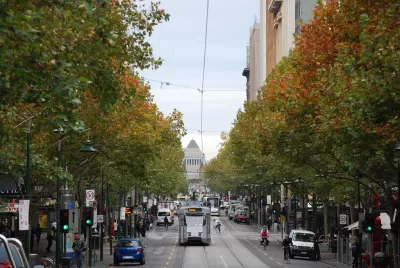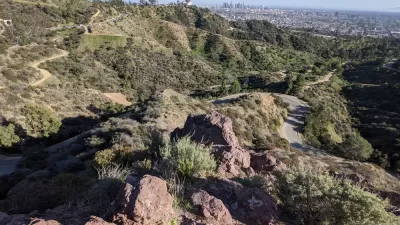In the mid-1980s, a tug-of-war over the future of one of Melbourne, Australia's most important streets took place with those wanting full pedestrianization realizing their vision for one brief, shining moment.

In February 1985, for a brief window of time, Melbourne's Swanston Street was transformed from asphalt carrying vehicles and a tram to a pedestrian promenade covered in grass. The urban intervention, as described by Lucy Salt in the Kill Your Darlings journal, was the product of a hard fought struggle between the state Ministry for Planning and Environment and the City of Melbourne. The state ministry was led by Professor David Yencken who, along with his team, had advocated the street be limited to pedestrians on a full-time basis. The city had rejected the state's plans, instead seeking a partial pedestrianization of the street allowing some vehicles to move through.
In early 1985, as part of the 150-year anniversary celebration of the state of Victoria, Yencken's team got their wish at least for a few days. At a cost of $550,000, the entire street was covered in fresh sod for one weekend.
After months of preparation, [Yencken's team member Sonja Peter] remembers watching the crowds promenade, take in the performances, play ball, walk their dogs, or simply sit. The massive pop-up park had completely transformed the street and set to work on people’s imaginations.
‘The acoustics changed, the smell and whole feeling changed, so people responded immediately to that,’ says Peter.
When the wet grass became muddy, people took off their shoes and strolled along. Peter also recalls feeling vindicated upon seeing the reactions of the ministry staff who’d come down to help out.
‘No-one knew what we had in mind, there was a lot of scepticism, and so to unroll the event by laying out the grass was spectacular.’
The grass had removed all trace of the traffic from the street, with the exception of a marooned W-Class tram standing as a proud centrepiece. The sun-warmed grass, wrote John Lahey in the Age, ‘smelled like the mouldering hay on a Gippsland farm’.
Yencken remains proud of the transformation of Swanston Street, although it was short lived. He sees Swanston Street as a pre-cursor to other urban interventions, including New York's Time Square, to which he gives a somewhat backhanded compliment: "New York now writes up the fact that they painted some spaces on Broadway and put a few pot plants out: Isn’t it revolutionary? And you’re going, Guys? Thirty years ago? And it wasn’t painted, it was actually grass!’
FULL STORY: Imagine a City: Swanston Street Party and the greening of Melbourne

Planetizen Federal Action Tracker
A weekly monitor of how Trump’s orders and actions are impacting planners and planning in America.

Chicago’s Ghost Rails
Just beneath the surface of the modern city lie the remnants of its expansive early 20th-century streetcar system.

San Antonio and Austin are Fusing Into one Massive Megaregion
The region spanning the two central Texas cities is growing fast, posing challenges for local infrastructure and water supplies.

Since Zion's Shuttles Went Electric “The Smog is Gone”
Visitors to Zion National Park can enjoy the canyon via the nation’s first fully electric park shuttle system.

Trump Distributing DOT Safety Funds at 1/10 Rate of Biden
Funds for Safe Streets and other transportation safety and equity programs are being held up by administrative reviews and conflicts with the Trump administration’s priorities.

German Cities Subsidize Taxis for Women Amid Wave of Violence
Free or low-cost taxi rides can help women navigate cities more safely, but critics say the programs don't address the root causes of violence against women.
Urban Design for Planners 1: Software Tools
This six-course series explores essential urban design concepts using open source software and equips planners with the tools they need to participate fully in the urban design process.
Planning for Universal Design
Learn the tools for implementing Universal Design in planning regulations.
planning NEXT
Appalachian Highlands Housing Partners
Mpact (founded as Rail~Volution)
City of Camden Redevelopment Agency
City of Astoria
City of Portland
City of Laramie




























